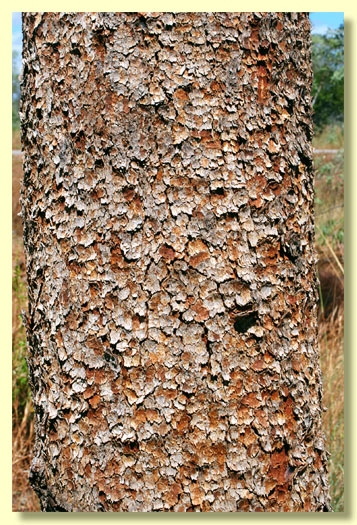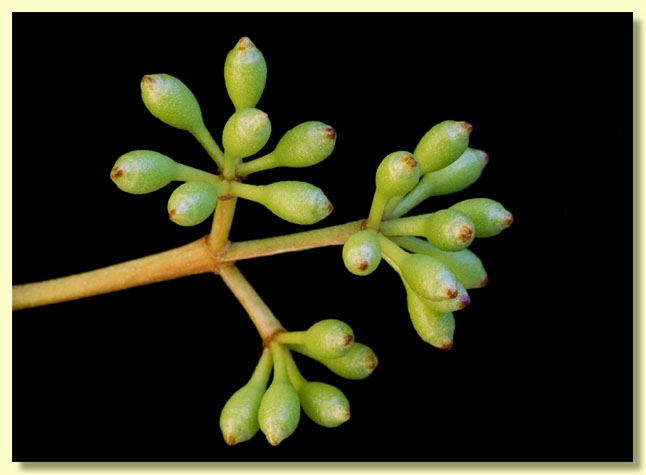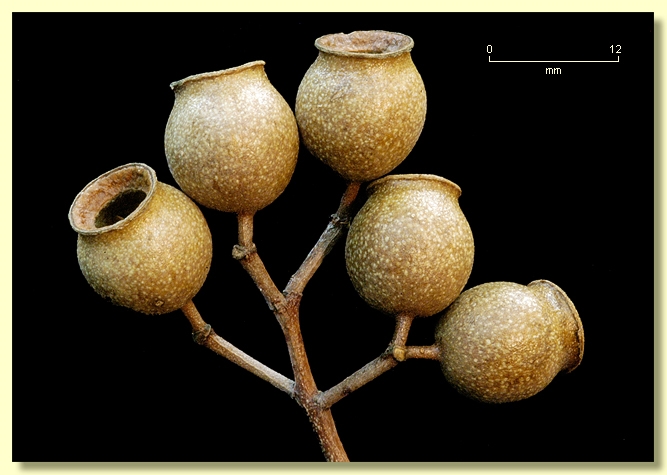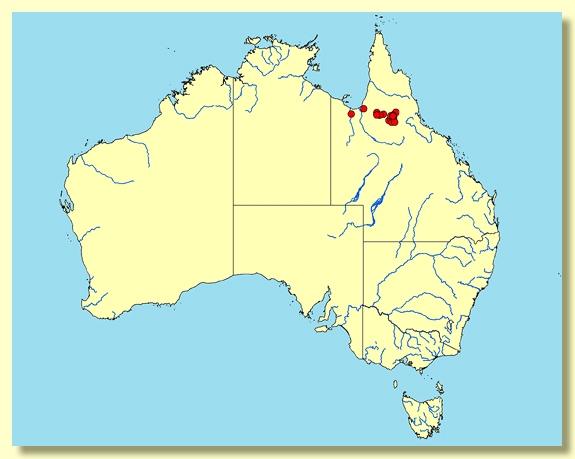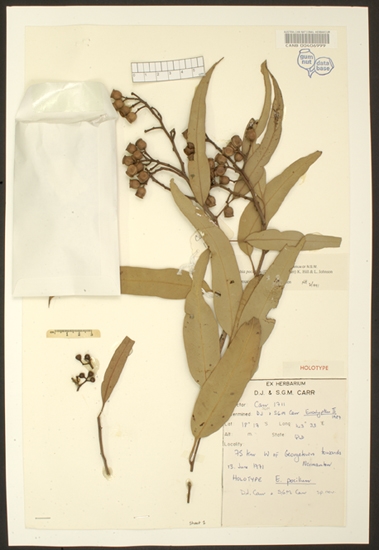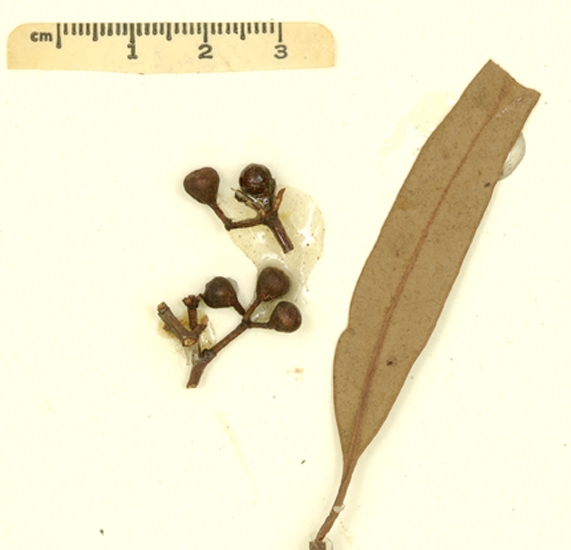Corymbia | Rufaria
Euclid - Online edition
Corymbia pocillum
Corymbia pocillum (D.J.Carr & S.G.M.Carr) K.D.Hill & L.A.S.Johnson, Telopea 6: 304 (1995).
Tree to 10 m tall. Forming a lignotuber.
Bark rough over most or all of trunk and sometimes larger branches down to ca 5 cm diameter or all branches smooth-barked; rough bark always of thin loose flakes that are grey to grey-brown flaking off in a tessellated pattern to reveal rich red-brown underbark, the larger branches frequently very reddish flaky becoming white and smooth.
Branchlets smooth (glabrous); elongated oil bodies may occur in the pith.
Juvenile growth (coppice or field seedlings to 50 cm): stems square to rounded in cross-section, glabrous; juvenile leaves always petiolate, opposite for ca 20 nodes then becoming alternate, linear-oblong to lanceolate, to 18 cm long, 3 cm wide, green, glabrous.
Adult leaves alternate, petioles 1.1–2.7(3.5) cm long; lanceolate, 8–20.5 cm long, 0.7–3 cm wide, base tapering to petiole, margin entire, apex pointed, concolorous, dull, green, smooth, side-veins at greater than 45° to midrib (penniveined), reticulation dense to very dense, intramarginal vein not visible (confluent with margin), oil glands small, island, few. New growth in crown has been described as ephemerally scurfy.
Inflorescence terminal compound, peduncles ± rounded, 0.4–1.6 cm long, buds 7 per umbel, pedicels 0.2–0.7 cm long. Mature buds obovoid or pyriform, 0.5–0.6 cm long, ca 0.4–0.55 cm wide, ultimately smooth and shiny though ephemerally scurfy when very young, scar absent (both opercula shed together at flowering), operculum shallowly rounded or flattened, scarcely apiculate, stamens inflexed, all fertile, anthers oblong, dorsifixed, versatile, dehiscing by longitudinal slits, style as long as the floral cavity, straight, stigma blunt and with a fringe of papillae, locules 4, the placentae each with ca 4 or 5 vertical ovule rows or the rows indistinct. Flowers white.
Fruit pedicellate (pedicels 0.1–0.5 cm long), urceolate-globose in outline narrowed above to a short neck with the thin rim flared, 0.9–1.4 cm long, 0.8–1.2 cm wide, longer than wide, surface smooth, disc descending vertically, valves 4, enclosed.
Seeds brown, 6–8 mm long, ellipsoidal with terminal wing, hilum ventral.
Cultivated seedlings (measured at ca node 10): cotyledons large, reniform; stems very sparsely setose only on lowest internode, the setae much reduced and wart-like; leaves always petiolate (petioles to 0.9 cm), opposite for at least 13 nodes, narrowly oblong-lanceolate, 8–17 cm long, 1.3–2.6 cm wide, base rounded or tapering, green, ± concolorous, sparsely setose only on lowermost leaves then glabrous.
Flowering has been recorded in January, February and June.
Bloodwood tree endemic to Queensland and restricted in distribution to the area south-east of Normanton to the western Newcastle Range and further south to the western Gregory Range north of Hughenden. It occurs in tropical seasonally dry woodlands on rocky sandstone and granite rises and laterite outcrops. Corymbia pocillum has thin rough scaly to tessellated bark conspicuously reddish when newly exposed, a dull green crown of concolorous leaves with no visible intramarginal vein, small smooth buds with pedicels 0.2–0.7 cm long and small urn-shaped fruit 0.9–1.4 cm long and 0.8–1.2 cm wide.
C. pocillum is distinguished from the closely related C. ellipsoidea by the smaller more globose fruit, though there is some overlap in width, and distinguished from clay-dwelling C. erythrophloia by the narrower juvenile leaves and the smaller fruit. Other rough-trunked bloodwood species in north-eastern Queensland, viz. C. clarksoniana, C. hylandii, C. stockeri, C. intermedia, C. polycarpa, C. serendipita and C. trachyphloia all differ from C. pocillum in having adult leaves that are darker above and paler on underside.
C. pocillum is a relatively poorly known species and its relationship to the more widespread C. dichromophloia (here including C. capricornia) warrants investigation. C. pocillum seems to have more rough bark than the essentially smooth-barked (with some adherent rough red flakes) C. dichromophloia, and to have narrower juvenile leaves that become glabrous earlier.
Brooker and Kleinig (1994) included this species (as Eucalyptus pocillum) and another species, E. ellipsoidea, in synonymy with E. erythrophloia.
MORE ABOUT CORYMBIA
MORE ABOUT RED BLOODWOODS
Corymbia pocillum: Latin pocillum, a small goblet or cup, referring to the small fruit of this species.


